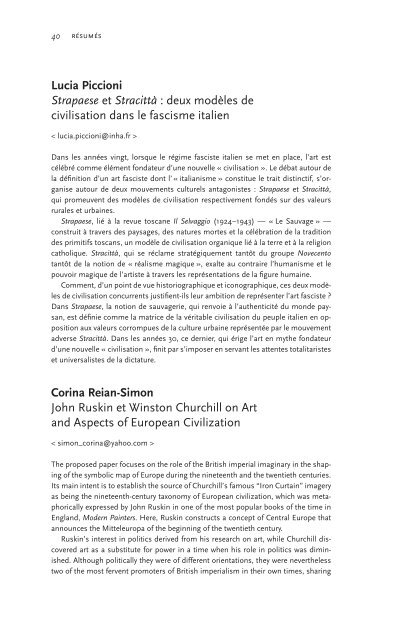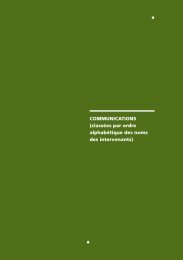Programme et Abstracts (PDF) - Réseau International pour la ...
Programme et Abstracts (PDF) - Réseau International pour la ...
Programme et Abstracts (PDF) - Réseau International pour la ...
You also want an ePaper? Increase the reach of your titles
YUMPU automatically turns print PDFs into web optimized ePapers that Google loves.
40<br />
résumés<br />
Lucia Piccioni<br />
Strapaese <strong>et</strong> Stracittà : deux modèles de<br />
civilisation dans le fascisme italien<br />
< lucia.piccioni@inha.fr ><br />
Dans les années vingt, lorsque le régime fasciste italien se m<strong>et</strong> en p<strong>la</strong>ce, l’art est<br />
célébré comme élément fondateur d’une nouvelle « civilisation ». Le débat autour de<br />
<strong>la</strong> définition d’un art fasciste dont l’ « italianisme » constitue le trait distinctif, s’organise<br />
autour de deux mouvements culturels antagonistes : Strapaese <strong>et</strong> Stracittà,<br />
qui promeuvent des modèles de civilisation respectivement fondés sur des valeurs<br />
rurales <strong>et</strong> urbaines.<br />
Strapaese, lié à <strong>la</strong> revue toscane Il Selvaggio (1924–1943) — « Le Sauvage » —<br />
construit à travers des paysages, des natures mortes <strong>et</strong> <strong>la</strong> célébration de <strong>la</strong> tradition<br />
des primitifs toscans, un modèle de civilisation organique lié à <strong>la</strong> terre <strong>et</strong> à <strong>la</strong> religion<br />
catholique. Stracittà, qui se réc<strong>la</strong>me stratégiquement tantôt du groupe Novecento<br />
tantôt de <strong>la</strong> notion de « réalisme magique », exalte au contraire l’humanisme <strong>et</strong> le<br />
pouvoir magique de l’artiste à travers les représentations de <strong>la</strong> figure humaine.<br />
Comment, d’un point de vue historiographique <strong>et</strong> iconographique, ces deux modèles<br />
de civilisation concurrents justifient-ils leur ambition de représenter l’art fasciste ?<br />
Dans Strapaese, <strong>la</strong> notion de sauvagerie, qui renvoie à l’authenticité du monde paysan,<br />
est définie comme <strong>la</strong> matrice de <strong>la</strong> véritable civilisation du peuple italien en opposition<br />
aux valeurs corrompues de <strong>la</strong> culture urbaine représentée par le mouvement<br />
adverse Stracittà. Dans les années 30, ce dernier, qui érige l’art en mythe fondateur<br />
d’une nouvelle « civilisation », finit par s’imposer en servant les attentes totalitaristes<br />
<strong>et</strong> universalistes de <strong>la</strong> dictature.<br />
Corina Reian-Simon<br />
John Ruskin <strong>et</strong> Winston Churchill on Art<br />
and Aspects of European Civilization<br />
< simon_corina@yahoo.com ><br />
The proposed paper focuses on the role of the British imperial imaginary in the shaping<br />
of the symbolic map of Europe during the nin<strong>et</strong>eenth and the twenti<strong>et</strong>h centuries.<br />
Its main intent is to establish the source of Churchill’s famous “Iron Curtain” imagery<br />
as being the nin<strong>et</strong>eenth-century taxonomy of European civilization, which was m<strong>et</strong>aphorically<br />
expressed by John Ruskin in one of the most popu<strong>la</strong>r books of the time in<br />
Eng<strong>la</strong>nd, Modern Painters. Here, Ruskin constructs a concept of Central Europe that<br />
announces the Mitteleuropa of the beginning of the twenti<strong>et</strong>h century.<br />
Ruskin’s interest in politics derived from his research on art, while Churchill discovered<br />
art as a substitute for power in a time when his role in politics was diminished.<br />
Although politically they were of different orientations, they were nevertheless<br />
two of the most fervent promoters of British imperialism in their own times, sharing<br />
the same views about the importance of the Empire for the British identity and the<br />
need to protect its interests in continental Europe or elsewhere.<br />
Ruskin saw art and politics as human constructions based on <strong>la</strong>ws “of help” or “of<br />
corruption,” while Churchill regarded them in terms of warfare based on strategies,<br />
tactics and confrontation. However, in times of maximum crisis, such as the Crimean<br />
War and the Second World War, they developed simi<strong>la</strong>r, strong geopolitical imageries,<br />
and these imageries deal with intra-European frontiers and the concept of Western<br />
civilization.<br />
Inderbir S. Riar<br />
Notes from the Underground City<br />
< sr1@columbia.edu ><br />
résumés 41<br />
This paper examines the critical response to the emergence of the “underground<br />
city” in Montreal during the 1960s. The focus will be on how the underground city<br />
was contextualised in architectural culture as a new type of urbanism, one that<br />
presumably departed from the conventions of functionalism articu<strong>la</strong>ted by the<br />
Modern Movement. Critics such as P<strong>et</strong>er B<strong>la</strong>ke, the famed editor of Architectural<br />
Forum, and Reyner Banham discovered in Montreal evidence of an urban “n<strong>et</strong>work”<br />
or “organism.” Celebrated for its “megastructural” properties, the underground (or,<br />
in B<strong>la</strong>ke’s par<strong>la</strong>nce, “multilevel”) city would, in turn, be used by local architects to<br />
project new ways of reorganising social life.<br />
The underground city presents a curious historical and spatial reversal: the avantgarde<br />
city was a cultural and industrial entity organised by visible hierarchies of function;<br />
y<strong>et</strong> its antithesis found expression in a n<strong>et</strong>herworld without any discernible<br />
form—a compl<strong>et</strong>ely interiorised environment, totally artificial, and entirely built rather<br />
than given. Thus would grow a new critique against the validity of supporting a subterranean<br />
urbanism at the expense of traditional stre<strong>et</strong> life as found in the existing city.<br />
Montreal’s underground city is a remarkable instance of the modernist desire to<br />
design the city as a “whole.” Y<strong>et</strong> it is a p<strong>la</strong>ce that has been unable to transcend itself,<br />
and remains an ambiguous terrain of quasi-public functions. As such, it points to how<br />
even the most visionary hopes for a “n<strong>et</strong>work” have become “splintered” as the city is<br />
increasingly divided for the use of high-value users and consumers.



